No country, developing or modern, can take access to water for granted. Climate change does not discriminate -- and a holistic approach to water management is essential. Aided by digital solutions and the provisioning of quality data can go a long way in optimizing water conservation and facilitating its reuse. To this end, the Hitachi group has been engaging customers and partners worldwide in the co-creation of AI-enabled water management solutions that go beyond big data to generate actionable data and insights.
In this techno talk, Ravigopal “Ravi” Vennelakanti, VP and head of the Big Data Analytics Lab at Hitachi America R&D, leads a discussion on how DragonflySM -- an AI-enabled sewage pipe inspection solution that his team co-created with global engineering firm Jacobs Solutions, Inc. and Hitachi Vantara Corporation -- delivers insights that potentially could transform critical industry workflows.
Ravi is joined by his co-creation partners, Raja Kadiyala, VP and Global Technology Officer at Jacobs, and Rajesh Devnani, VP, Energy and Utilities at Hitachi Vantara. The takeaway: the water industry is ripe for change and actionable data can be a powerful catalyst for propelling it forward.
(Published 20 July 2023)
Ravi
Let’s start with Jacobs’ OneWater initiative since it addresses water usage overall and puts Dragonfly in context.
Raja
Sure. Dragonfly and our overall push for digital transformation in the water sector is an extension of our OneWater approach -- an integrated, collaborative approach to complex water management challenges. By looking holistically at water’s connections to communities and cultures, we develop solutions that provide comprehensive benefits. These solutions focus on optimizing the planning, implementation, and operations of the complete water cycle, including surface water, groundwater, desalination, stormwater and flood management, conveyance, wastewater, reuse, and environmental flows.
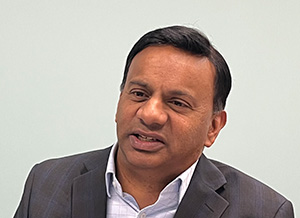
By taking a holistic view of our client’s challenges across the entire water cycle and the lifecycle of the underlying assets, we can deploy integrated data solutions that provide comprehensive benefits. We recognize the importance of a complete system-wide digital approach that moves beyond optimizing assets and networks in isolation. Also, water challenges are interconnected. We look at water’s connections to land, food, and energy to solve complex water management and community challenges in the present as well as the future. Finally, water solutions must be sustainable, inclusive and equitable. We try to be inclusive in our planning, considering the needs of all those who influence or are influenced by water, and prioritizing solutions that benefit people, the environment and the economy.
Also, water challenges are interconnected. We look at water’s connections to land, food and energy to solve complex water management and community challenges in the present as well as the future.
Digital solutions are key to meeting larger-scale water challenges such as water scarcity in states like California. We use digital solutions to both improve conservation by minimizing water loss from leakages and optimize wastewater and stormwater for reuse projects. Just recently we implemented a digital twin to optimize the design of San Diego’s water recycling program, which has been extremely successful and beneficial to the local community.
Ravi
That story segues nicely to how we’re using AI for Dragonfly. Could you tell our audience about the solution and its benefits to utilities and other stakeholders? Aging water systems are a global issue, as are staffing challenges. How does Dragonfly address these challenges?
Raja
Dragonfly is part of Digital OneWater initiative, which provides an integrated ecosystem of data-enabled solutions. It’s an AI-enabled solution that allows clients to take inspection video from sewer pipes or storm drainpipes and automatically analyzes that video for defect codes. There's an industry standard for conducting these kinds of analyses. Dragonfly takes that video input and then scores it against that industry standard.
The traditional inspection process is extremely manual, whereby somebody has to look through every single frame in the inspection video and score against the standard. Utilities only inspect 10 percent of their total footage annually. That means it takes 10 years to inspect and analyze everything. A lot can happen in those 10 years.
So, Dragonfly frees up utility staff to do more beneficial work. To your point, this is particularly important because there’s a huge staffing shortage in the industry. Many experts in the field are approaching retirement age.
Also, depending on who's looking at that video, the scoring may differ from person to person. With AI, the scoring process is very uniform. We can get consistent data. This is, of course, critically important because utilities are making big decisions about where to invest their capital, which pipes need to get replaced or realigned, based on that data. Having consistent and accurate data is key to the overall workflow. Most importantly, Dragonfly is prescriptive. It not only scores inspections, but also provides guidance to the utilities based on what it observes. So, we can say, “This segment of pipe is in good condition. It will need to be inspected in five years. This other one, however, needs to be relined.” Dragonfly provides prescriptive, actionable data, which of course is what utilities truly value.
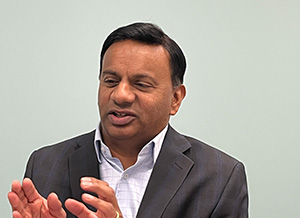
Ravi
What kind of feedback are you receiving from the industry? Are utilities keen on leveraging such actionable data, let alone digital solutions? I believe it’s imperative that they are given that pipes make up a large portion of their assets.
Raja
Indeed. They’re very familiar with, “Here’s a video. Here’s the defect coding.” Then we get into the prescriptive side to guide them on what they should be doing, and that’s a huge benefit for them, and they're often wowed by that aspect of it. Otherwise, they would’ve had to look at that additional data and try to make sense out of all those defect codes.
Again, CIOs tell me they use a paltry 10 percent of the data they generate. We’re taking the rest of the data that they don't use and providing guidance on what to do with it. The water sector is very hesitant to adopt new technologies, so there are many pilots where they’re very careful about evaluating the analysis coming back. The data that we provide has been spot on.
There are regulatory elements that come into play in the U.S. as well. Utilities that don't manage their assets properly typically get put under what's called a consent decree, and those utilities will have to inspect a certain number of linear feet or mileage of their assets per year.
An AI-enabled solution like Dragonfly is ideal for those utilities under a consent decree because oftentimes it's a heavy burden on their staff. Getting back that accurate data and analysis to provide guidance to them is a huge benefit.
Ravi
What does the landscape look like for AI-enabled solutions in the water sector? Where’s the opportunity for differentiation?
Raja
The way we see it, there are two types of solutions. There are a small number of VC-backed firms that are focused on just data delivery. Then you have the traditional providers trying to analyze captured data.
We think we have a leg up due to our market presence. We are unique in that we have extensive domain expertise. We’ve been working in the water sector for nearly a century. The knowledge we have about how certain assets behave, and being able to provide prescriptive analytics is unique to our solution.
What we’re promoting is “actionable data.” We’re informing the AI process with our deep domain knowledge and the unique data sets that we have. This is really where the value resides.
Ravi
Rajesh, how would you explain the Jacobs, Hitachi America R&D, and Hitachi Vantara trifecta? In my view, at Hitachi, we start with the question: how can we enable our customers to grow and succeed?
If we were a startup, Dragonfly may have been a less-than-perfect technology that needed a problem to solve. Thanks to our co-creation process with Jacobs, along with our experience in Japan, we started with solid understanding of the problem and were able to develop a solution for it. We’re really walking in step with our customers and partners to demonstrate, validate, and build technology at scale and at the speed of the business. Would you agree?
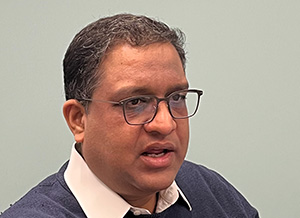
Rajesh
Indeed, I do. But I think we do more. We have Jacobs, which has unequaled domain expertise and technology expertise. We have Hitachi America R&D, which has great expertise in AI and machine learning as well as knowledge about the water industry accumulated from Hitachi’s extensive experience in Japan. My understanding is that we deployed a solution like Dragonfly at a regional utility in 2021. As for Hitachi Vantara, we bring a good mix of infrastructure, hardware and software, and professional services skills. Vantara also provides commercial and scaling expertise as solutions like Dragonfly take on a life of their own and develop from a prototype stage to the commercial market.
So, in addition to co-creation, our partnership is about scaling. It’s the right mix that works in partnership with customers to launch offerings that are competitive and differentiated in the marketplace. And that's really what our approach is all about.
We have many examples of where we’ve partnered with R&D and select partners, like Jacobs, to enable that and deliver business value to customers. The market is shifting towards designing specific outcomes for customers. The solutions that we provide are a classic example of that. They offer real value in terms of automation and improving efficiency and consistency by leveraging AI. That’s what customers are expecting.
Hitachi is an industrial organization at large. Industrial AI is in our roots. How do we apply that in an innovation context and bring about clear benefits for industrial businesses? How do we support the critical infrastructure that underlies all these organizations? It’s about the security and reliability of that underlying infrastructure.
Ravi
Do you see opportunities beyond wastewater management for AI-enabled inspection solutions?
Rajesh
You’re right. What we’re talking about is a vision-based technology that has various applications. As Raja said, both Jacobs and Hitachi are large conglomerates operating across multiple verticals, and there's a lot of cross-pollination that can happen across various solutions or use cases as well.
Now, the first use case is in water and wastewater management, but what's the art of the possible? That’s the next level of thinking that we'll evolve to, once we achieve success with wastewater management.
How do we conjure this use case in different contexts? How do we take it to the larger critical infrastructure? Not just wastewater, but across water at large, across different sorts of pipelines at large, and even in different market contexts, like electrical utilities? I think the AI-enabled inspection market is evolving at a very rapid clip, at 26 percent CAGR by some estimates. So, it's a large, evolving market, and we can, in collaboration with Jacobs, capture a significant part of it.
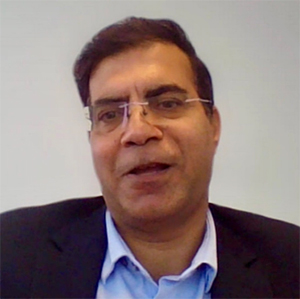
Ravi
As you know, we’ve lined up our deliverables for Jacobs to sell to the first movers in the market. But in terms of the research itself, a lot is now pivoting from model improvement to data improvement.
How do we improve the quality of insights we derive from the data at a lower price point? How do we deliver insights that are invaluable? You can't do that with human augmented processes. You have to be able to innovate and deliver value from data that's being captured at a low price point. Clearly, automation is the key. How do we augment and improve the quality of data, so it supports human efforts? Are these the right questions to ask?
Raja
Yes, definitely. We're certainly getting an avalanche of data, and as it streams in, it’s allowing us to refine the algorithm, so we have a constant process of improvement.
That said, there are utilities sitting on video that they've never looked at. Certain utilities have 10 years of video that they’ve just not had the chance to analyze. If you look at that video that 10-years old video, compared to the quality of the video we can capture now, there’s a huge difference. How can we provide additional quality data to provide actionable insights in terms of what's happening now?
We utilize multiple senses when we're trying to assess what's going on. And in a very similar sense, utilizing multiple data to understand what's going on can provide an interesting and valuable lens on things.
The AI we’re implementing is an ensemble of machine learning algorithms that provide guidance on what's really going on with the asset. I can't say that we've seen every single type of video material out there, but it is a continuous process where the algorithm is improving. And that's, again, where our domain knowledge comes into play. When we see something new, how do we guide the machine learning algorithm to better identify it, to provide more actionable data, going forward?

Technology adoption in the water sector is at a crossroads. While AI-based solutions and the actionable insights they generate cannot solve all its challenges, they can play a pivotal role in the conservation and reuse of water by enabling the maintenance of its infrastructure and keeping it up to standard. The outcomes of Hitachi America R&D’s co-creation efforts with Jacobs serve as evidence. Jacobs’ Dragonfly delivers accurate and consistent data as well as prescriptive guidance on likely issues, thus freeing up valuable human and financial capital. Unpredictable access to water resulting from climate change requires proactive, as well as holistic, water management. The status quo of manual processes is no longer viable. Prescriptive, actionable insights are essential. Communities worldwide are counting on it.
*Jacobs, the Jacobs logo, and DragonflySM are used with permission and are trademarks of Jacobs Solutions, Inc.
(As at the time of publication)
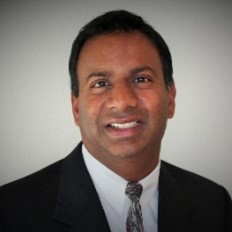
Raja R. KADIYALA, Ph.D.
Vice President and Global Technology Officer,
Senior Technology Fellow,
Jacobs
Dr. Kadiyala is a Vice President and Senior Technology Fellow at Jacobs. He is currently serving as the Global Technology Officer. In this role, he provides leadership, direction, and oversight to Jacobs’ Digital Strategy, Data and Technology, and Product Development. Technology areas covered in his remit include Digital Twins, Process Control Systems, Optimization, Predictive Analytics, Information Modeling, Smart Metering, Artificial Intelligence, IoT and Smart Sensing, Automated Design, Augmented and Virtual Reality, Geospatial Analytics and Integration, Geodesign, Physical Security, Cybersecurity and Emergency Preparedness solutions for public and private sector clients worldwide.
Over his 29-year career at Jacobs, Dr. Kadiyala has worked to plan and implement information and security system solutions across the globe. He has also focused on real-time sensing, machine learning, digital twins, control, and analytics for operational optimization. Many of his current efforts are centered on the development of Realtime solutions to provide insight into the overwhelming amount of data generated daily. Before joining Jacobs, Dr. Kadiyala worked as a development engineer in the aerospace industry and industrial process control space. He was also a control systems engineer within the Flight Systems Division at NASA and an R&D manager in the automotive and semiconductor manufacturing robotics arena.
Dr. Kadiyala received his Bachelor of Science, with highest distinction, from Purdue University. He subsequently received his Master of Science and doctorate from the University of California at Berkeley, all in electrical engineering. linkedin.com/in/rajakadiyala/
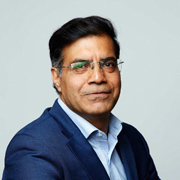
Rajesh DEVNANI
Vice President, Energy & Utilities
Hitachi Vantara
Rajesh currently leads the Energy & Utilities vertical for Hitachi Vantara US. In this role, his focus is on delivering Client success through an Industry-centric value proposition leveraging the Digital Solutions portfolio of Hitachi Vantara and the larger Hitachi Group.
He is a member of the organization’s Digital Solutions leadership team with a charter to drive exceptional growth through a Consulting led business benefits driven approach leveraging the Digital Solutions portfolio and being a trusted advisor to clients. His previous experience includes leading the Global Digital Solutions function at Hitachi Consulting and creating a comprehensive Digital solutions portfolio spanning multiple verticals. linkedin.com/in/rajesh-devnani-383a242/
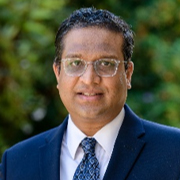
Ravigopal (Ravi) VENNELAKANTI
Vice President
& Head of the Big Data Analytics Solutions Laboratory,
R&D Division, Hitachi America, Ltd.
Ravi joined Hitachi America R&D in 2013 and has over 25 years of research and innovation experience accelerating technologies from lab to market.
At Hitachi America R&D, he specializes in digital transformation and solutions research applied to several industry domains leveraging data-centric strategies and technologies, addressing the challenges across the complete value chain of an industry's ecosystem. linkedin.com/in/ravigopal-vennelakanti-8759742/details/experience/